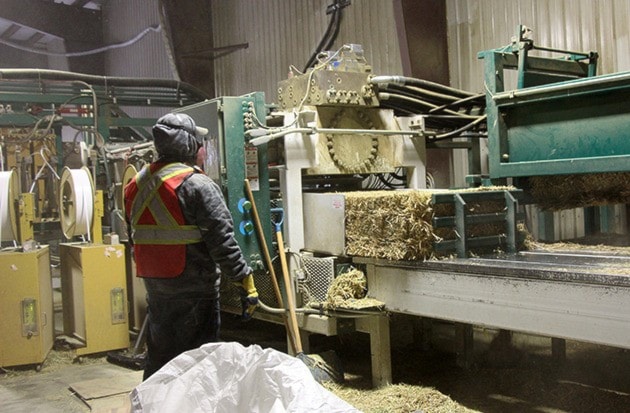Vanderhoof’s hay is now nourishing livestock beyond Canada, reaching animals in Asia and the Middle East.
Showcasing its hay-pressing machinery to over 30 members of Vanderhoof’s farming community in March, the Vanderhoof-based Tophay Agri-Industries Inc. is looking to expand its operations through local support, said the company’s spokesperson Relax Ding.
Currently producing 10,000 to 15,000 metric tons of hay per year, Tophay aims to eventually increase its production to 50,000. This summer, the company will expand its equipment for hay compression to double its current size, Ding said.
The machine cuts bales into three pieces and presses each to half its volume, producing blocks of 25 to 30 kilograms that are easy for conservation and shipping, he explained.
“We can’t produce all the hay by ourselves, so that’s why we are working with the local farmers, to benefit each other,” he said, adding that hay is currently priced at $290 to $350 USD, while bales that have been rained on — about 30 per cent of all produced — tend to decrease in value by $50.
“Our idea is to sell all the products from the farmers,” Ding said.
Started in 2012, the company began with 72 acres of land on Carmen Hill Road West and now owns 12,000 acres in the region, he explained.
Its directors, involving with China-based international businesses of various sectors such as logistics and electronics, found that China imported a large amount of alfalfa from the United States, and picked Vanderhoof for its location, he said.
“Vanderhoof is the second biggest farming community in B.C.,” Ding said. “It’s close to Prince George railway station, where we ship the hay to Prince Rupert.”
The central B.C. climate is also a factor in the quality of hay produced.
“Here there’s good land and good water,” Ding said. “The hay retains more sugars, since it’s so hot in the day and so cold at night in the north.”
In the past, Japan was the biggest hay purchaser with 1 million tons per year, but China rose to the top this year with 1.2 million tons — Tophay customers included sheep farmers, race horsing associations, and Cirque de Soleil in China, he said.
In the Middle East, Tophay’s hay was sold as feedstock for camels and dairy productions, and the company looks to explore the Japanese market this year.
“People realize that quality hay will give them good production of the milk,” Ding said.
Last June, David Martens and Sons Limited sold 3,200 acres of its 6,000-acre holdings to Tophay.
The 60-year-old business, managed by David’s six children for the last 30 years after he died, kept its dairy production under Allan Martens and its beef herd under Richard Martens, as well as 1,000 acres under Dale and Sheila Martens, Dale said.
“I think it’s been a positive thing for the community,” he said. “There’s extra options for the farmer to market their feed.”
The couple looks to sell 300 acres of hay to Tophay this year, while Dale’s brothers will be cooperating with the company by trading high quality hay for feed of lower quality, Dale explained.
“The cow calves usually use up your poor feed…they can survive on almost anything,” he said. “Might as well export the good stuff.”
In the past, the family’s hay was used to feed livestock in the region.
“Some years, of course, it’ll be better to sell the feed and they might make more that way than they do with the cattle.” Dale explained. “It’s like any other business…there are years where the cattle prices are good.”
For Mayor Gerry Thiessen, who also attended the machinery showcase, the growth of hay exporting from Vanderhoof helps with the community in diversifying its industries.
“Agriculture has always been the mainstay of Vanderhoof,” Thiessen said. “Nothing is a silver bullet, but bit by bit, it adds to our community.”
